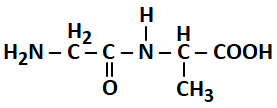Select Chapter Topics:
Unlock IMPORTANT QUESTION
This question was bookmarked by 5 NEET 2025 toppers during their NEETprep journey. Get Target Batch to see this question.
✨ Perfect for quick revision & accuracy boost
Buy Target Batch
Access all premium questions instantly
Consider the following reactions:
'x', 'y', and 'z' in the above-given reactions are, respectively:
1. 5, 4, and 5
2. 4, 6, and 5
3. 4, 5, and 5
4. 5, 6, and 5
| (i) | \(\small\text {Glucose + ROH} \xrightarrow { \text {dry HCl}} \text {Acetal} \xrightarrow [(CH_3CO)_2O] { x~ eq. of} \text {acetyl derivative}\) |
| (ii) | \(\text {Glucose } \xrightarrow { \text {Ni}/H_2} \text {A} \xrightarrow [(CH_3CO)_2O] { y~ eq. of} \text {acetyl derivative}\) |
| (iii) | \(\text {Glucose } \xrightarrow [(CH_3CO)_2O] { z~ eq. of} \text {acetyl derivative}\) |
1. 5, 4, and 5
2. 4, 6, and 5
3. 4, 5, and 5
4. 5, 6, and 5
Subtopic: Carbohydrates - Classification & D-L configuration |
Level 3: 35%-60%
Please attempt this question first.
Hints
Please attempt this question first.
Which of the following is true about a glycosidic linkage?
1. It contains a carbonyl bond.
2. It contains an ether bond.
3. It contains an ester bond.
4. It contains an amide bond.
1. It contains a carbonyl bond.
2. It contains an ether bond.
3. It contains an ester bond.
4. It contains an amide bond.
Subtopic: Carbohydrates - Classification & D-L configuration |
Level 3: 35%-60%
Please attempt this question first.
Hints
Please attempt this question first.
| Statement I: | Pentaacetate of cyclic glucose reacts with hydroxylamine |
| Statement II: | Glucose on oxidation with nitric acid yields gluconic acid. |
| 1. | Statement I is correct but Statement II is incorrect |
| 2. | Statement I is incorrect but Statement II is correct |
| 3. | Both Statement I and Statement II are correct |
| 4. | Both Statement I and Statement II are incorrect |
Subtopic: Carbohydrates - Classification & D-L configuration |
51%
Level 3: 35%-60%
Please attempt this question first.
Hints
Please attempt this question first.
Consider the sugars labeled X and Y in the image. Which of the following statements about sugars X and Y is/are not correct?

Option:
1. a, b
2. a, d
3. a, c, d
4. b, c

| a. | X is a reducing sugar and Y is a non-reducing sugar. |
| b. | X is a non-reducing sugar and Y is a reducing sugar. |
| c. | The glucosidic linkages in X and Y are \(\alpha\) and \(\beta\) respectively. |
| d. | The glucosidic linkages in X and Y are \(\beta\) and \(\alpha\) respectively. |
1. a, b
2. a, d
3. a, c, d
4. b, c
Subtopic: Carbohydrates - Classification & D-L configuration |
Level 3: 35%-60%
Please attempt this question first.
Hints
Please attempt this question first.
Unlock IMPORTANT QUESTION
This question was bookmarked by 5 NEET 2025 toppers during their NEETprep journey. Get Target Batch to see this question.
✨ Perfect for quick revision & accuracy boost
Buy Target Batch
Access all premium questions instantly
D-Glucose→HNO3 (dil) A);
Product (A) is :-
Oxidation of Glucose with dil HNO3
1. D-Gluconic acid
2. D-Glucitol
3. Sacchric acid
4. D-Glucaric acid
Subtopic: Carbohydrates - Classification & D-L configuration |
Level 4: Below 35%
Hints
The fisher presentation of D-glucose is given below.

The correct structure(s) of -L-glucopyranose is (are):
| 1. |  |
2. |  |
| 3. |  |
4. |  |
Subtopic: Carbohydrates - Classification & D-L configuration |
Level 3: 35%-60%
Please attempt this question first.
Hints
Please attempt this question first.
The Fischer presentation of D-glucose is given below:

The correct structures of \(\beta-\)L-glucopyranose is (are)

The correct structures of \(\beta-\)L-glucopyranose is (are)
| 1. |  |
2. |  |
| 3. |  |
4. |  |
Subtopic: Carbohydrates - Classification & D-L configuration |
71%
Level 2: 60%+
Please attempt this question first.
Hints
Please attempt this question first.
Given below are two statements:
In the light of the above statements, choose the correct answer from the options given below:
| Statement I: | Glycogen is similar to amylose in its structure. |
| Statement II: | Glycogen is found in yeast and fungi also. |
| 1. | Statement I is correct and Statement II is incorrect. |
| 2. | Statement I is incorrect and Statement II is correct. |
| 3. | Both Statement I and Statement II are correct. |
| 4. | Both Statement I and Statement II are incorrect. |
Subtopic: Polysaccharides & their Importance |
51%
Level 3: 35%-60%
NEET - 2024
Hints
Unlock IMPORTANT QUESTION
This question was bookmarked by 5 NEET 2025 toppers during their NEETprep journey. Get Target Batch to see this question.
✨ Perfect for quick revision & accuracy boost
Buy Target Batch
Access all premium questions instantly
| Assertion (A): | Deoxyribose, , is not a carbohydrate. |
| Reason (R): | Carbohydrates are hydrates of carbon so compounds that follow the formula are carbohydrates. |
| 1. | Both (A) and (R) are True and (R) is the correct explanation of (A). |
| 2. | Both (A) and (R) are False. |
| 3. | (A) is True but (R) is False. |
| 4. | (A) is False but (R) is True. |
Subtopic: Polysaccharides & their Importance |
Level 3: 35%-60%
Hints
The correct structure of the dipeptide glycyl valine is:
| 1. |  |
2. |  |
| 3. |  |
4. |  |
Subtopic: α - Amino Acids, Peptide Bond, Proteins & Structure |
52%
Level 3: 35%-60%
Please attempt this question first.
Hints
Please attempt this question first.






